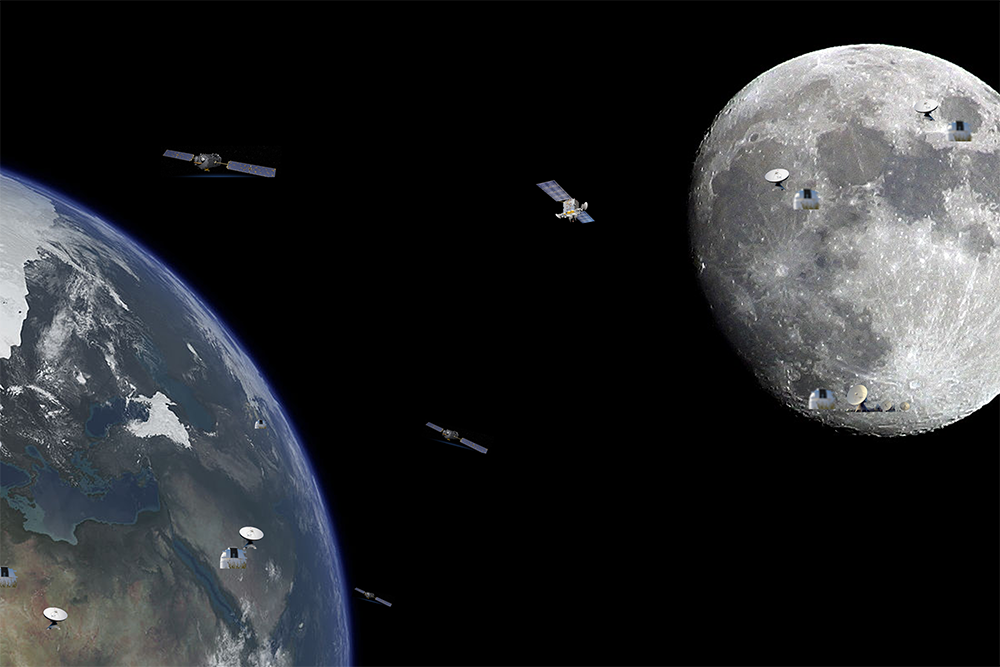Ontario Tech researcher leading one of the first projects to stream live data from the Moon
Dr. Carolyn McGregor developing new technologies to monitor astronauts’ health analytics in real time
March 16, 2021

It’s certainly a good idea to avoid long-distance charges whenever you can. It’s an even better plan when the other party is some 384,000 kilometres away.
Nearly a half-century has passed since the last time a human was on the Moon (December 1972 to be exact). But NASA hopes to return there with astronauts within the next three years. In advance of that next lunar mission, a U.S.-based company, CommStar Space Communications (CommStar), plans to launch a private data relay satellite (CommStar-1) in 2023, which would establish much-needed communications infrastructure for future missions in space.
And that’s where Ontario Tech University researcher Dr. Carolyn McGregor comes into the picture. Behind the scenes, the Faculty of Business and Information Technology Professor has been working with CommStar and its consortium of partners, including Laser Light Communications of Reston, Virginia.
On March 6, Dr. McGregor presented her latest research findings outlining an ‘end-to-end’ data distribution infrastructure, enabling real-time monitoring for astronaut health through cloud-based analytics via space data relays, at the Institute of Electrical and Electronics Engineers (IEEE) Aerospace Conference. Deep space hybrid radio frequency and optical networks have great potential to address the current gap in space communication networks.
“Ontario Tech will be the lead academic institution in this new form of space telecommunication, Internet of Things (IoT), real-time astronaut monitoring and equipment monitoring for Moon, ‘cislunar’ and Mars missions,” says Dr. McGregor. “This all follows Ontario Tech’s focus on ‘tech with a conscience’, as an advocate of responsible approach to technology innovation.”
The work with CommStar also involves IBM, IoT-platform SmartCone Technologies, and Ontario Tech’s Joint Research Centre in Artificial Intelligence (AI) for Health and Wellness with University of Technology Sydney in Australia.
“I am excited to be part of this paradigm-shifting, game-changing research that will have so much implication on how we think about provisioning technology solutions beyond low-Earth orbit for Mars and Moon missions,” says Dr. McGregor. “We are leading these new approaches to space data communications that will enable Ontario- and Canadian-based businesses to be part of an emerging ecosystem of providers and users on the Earth or the Moon, or someday beyond. We will also provide new experiential learning opportunities for students to gain experience on these new space applications for businesses.”
“Space data management is emerging as a key service sector, supporting humankind’s transition from the Earth to Near Space, the Moon, and someday Mars,” says Fletcher Brumley, CEO, CommStar. “Direct-to-Earth data flows will require state-of-the-art communications infrastructure and services, similar to what we have on Earth, tailored for the human experience off-planet. What Dr. Carolyn McGregor has outlined is an ‘end-to-end’ space-data management platform for the specific purpose of monitoring human health off-planet. We at CommStar are proud to be a part of her work and the potential benefits her design brings to the safe migration of humans off-planet.”
Backgrounder – Dr. McGregor’s Artemis Project
The health, wellness and adaption response of astronauts during spaceflight is a key component for the success of any space mission involving humans.
While physiological and psychological responses of astronauts during spaceflight have been monitored since the missions of the 1960s, earlier versions of communication networks to and within the spacecraft have limited methods to monitor the health and wellness of astronauts in real-time.
Over the past 15 years, Dr. McGregor has developed her Artemis big-data analytics platform that enables the capture and processing of physiological data and other clinical data in real-time, for new approaches to real-time health monitoring. First tested within the domain of neonatal intensive care, Artemis is proposed as an approach for autonomous health monitoring to support missions within and beyond low-Earth orbit.
Artemis Cloud enables health analytics as-a-service and has been demonstrated utilizing the Ontario Research and Innovation Optical Network (ORION) in Ontario.
About CommStar
On June 16, 2020 CommStar Space Communications™ LLC (CommStar Space), announced its intention to deploy an advanced proprietary data relay satellite (CommStar-1) to be located between the Earth and the Moon by 2023. Serving as an advanced network access point located in the Cislunar service area, CommStar-1 will be capable of receiving and relaying both optical and radio frequency communications between the Moon and the Earth. CommStar-1 will provide active, ‘always on’ advanced data services over the more than 384,000-kilometre (238,000 miles) distance, but situated closer to the Moon, 64,000 kilometres (40,000 miles) away.
Selected related university news story links for further background on Dr. McGregor’s research
- Dr. Carolyn McGregor’s AI big data analytics platform to assess human performance in any weather condition
- University’s Carolyn McGregor included in historic Ontario 150 storybook
- Ontario Tech University-based health informatics research goes out of this world
- Ontario Tech University-based health informatics research pushing new frontiers in critical care
- Ontario Tech University professor named 2015 Advance Global Australian Award winner
- Dr. Carolyn McGregor participates in U.S. podcast on Big Data
- Big Data: Inside the Algorithm
- Ontario Tech University's Dr. Carolyn McGregor profiled in new Science Museum exhibit in Britain
- Ontario Tech University researchers help support the transition to paperless health information system at Ontario Shores
- Ontario Tech University professor receives Australia’s highest honour
- Ontario Tech University-led Artemis Project captures national Ingenious Award
- Follow Dr. Carolyn McGregor on Twitter
Media contact
Communications and Marketing
Ontario Tech University
communications@ontariotechu.ca
1 > 1




